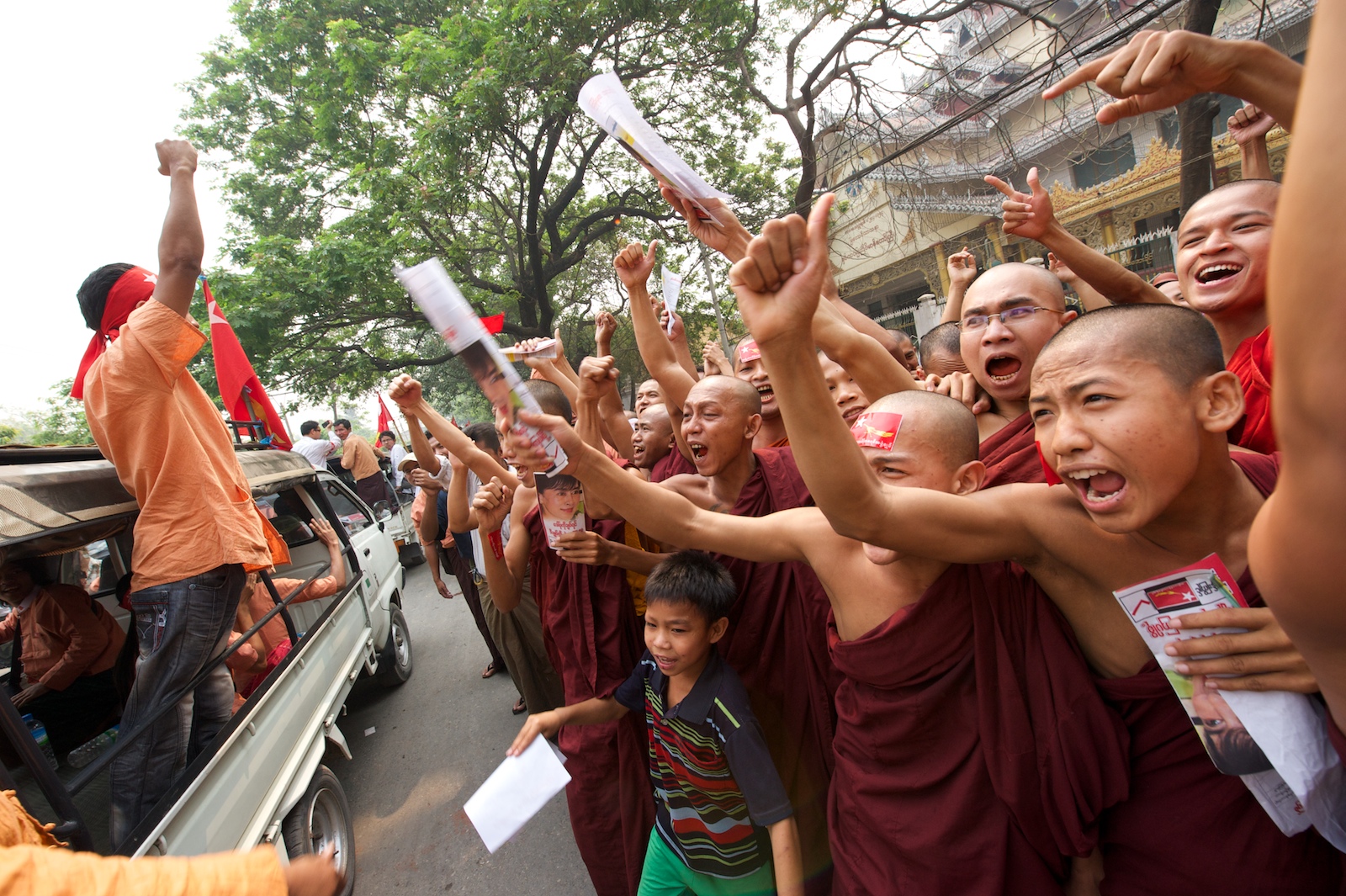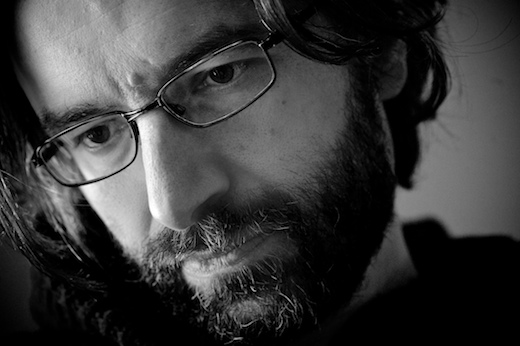Valerio Berdini: Monks, Myanmar
The Image
Photographer:
Valerio Berdini
Location:
Mandalay, Myanmar
Time / Date:
10:02 AM / March 31st, 2012
The Technical
Gear:
Camera Body: Nikon D700
Lens: Nikon 14-24mm f/2.8G ED AF-S
Camera Settings:
Shutter Speed: 1/320
Aperture: f/9.0
ISO: 1100
Focal Length: 14mm
The Story
Background:
“Good photographers and good journalists are master at communication, with a talent for presenting as accurately as possible what is happening in one part of the world to the rest of the globe. They are a boon to those of us who live in lands where there is no freedom of expression… Please use your liberty to promote ours”
— Aung San Suu Kyi
When I read this quote on the back of a book of Nobel Laureate Aung San Suu Kyi, Myanmar became the top country on my wish list of ‘places to go’.
Myanmar path towards democratisation, after half a century under one of the most brutal regimes the world has encountered, started with a referendum calling for a national election in 2010. 20 years since the last polls in 1990, won by the National League for Democracy (NLD, the party founded by Aung San Suu Kyi) but negated by the junta ever since.
My long awaited time to enter Burma became a reality at the end of 2011, when elections were called. I booked my flight and applied for a visa. Burma was on the verge of the pivotal change it dreamt for decades. I did not want to miss such a moment. My experience tells that the best time to visit a place from a photographer perspective is when something is happening.
I understand I was not alone on my “self-assignment” as soon as I arrived at the guest house I booked. I met two photojournalists and they told me that many more are scattered at hotels throughout town. On my first exploration of key spots in Yangon, I learnt that famed reporter, James Nachtwey was here for Time magazine; few days later I will chat with World Press Photo winner Pietro Masturzo on a sweaty morning spent waiting for Aung San Suu Kyi to appear at the NLD headquarters.
I decided to adjust my trip and spend the electoral days in Mandalay to dodge the international press set in Yangon. My project was not to cover the elections but to depict a changing Burma around and beyond the vote. I aimed to portray and acknowledge how humble people strove to achieve such a heroic milestone.
Mandalay, the second Burmese town, looked peaceful in the afternoon I got off an exhausting bus ride. When I decided to stretch my legs and have a stroll the night market was being set up. Several stalls were selling NLD merchandise and for some people it was the first time they could buy a poster or a t-shirt depicting the icons of the democratic resistance without the risk of being harassed or arrested.
The next morning I rented a motorcycle and its driver. My man would prefer to avoid troubles and carry me around the touristic path. Five minutes on our way towards a monastery, I noticed a workshop printing NLD flags. I told the driver to stop to let me see, he would rather go away. I perceived his anxiety but in the end he left me. I walked around a block and stumbled upon a vast crowd walking towards me. Hundreds of people were following a colourful NLD march dancing and chanting. There was neither police nor photojournalists. It was just they, their joy and I. I offered my driver a drink a and asked him to wait, it was a moment that asked to be reported.
I love to photograph mass gatherings; in the years I have covered massive political demonstrations, huge music festivals and the largest religious events from Círio de Nazaré in Brazil to the biggest of all, the Kumbh Mela in India. I did not want to miss this.
The Scene:
In a matter of seconds I was in the crowd. People on foot, bikes, and cars occupied a large road. I started shooting and quickly understood to be in an emblematic photojournalist situation. Two main rules apply. The first, set by Bob Capa decades ago, if I wanted a good picture I had to get close. Second, how to avoid people looking at the camera. To be in the middle of a large crowd helped to blend in, to be the only European did not. The most difficult task was not to take photos but to become transparent. My tactic was to make participants feel I was not an observer but one of them, supporting their cause. People looked at me but some did not concentrated on their cause. I noticed the parade was about to passing next to a Buddhist monastery. This was the moment. Several monks came out to support and applaud the march, euphoria and excitement was all around.
Buddhist monks have always had a key role in Burmese’s fight for democracy. In the past many have been shot dead for demonstrating, atmosphere today is joyful and peaceful. I stop and wait I see the car I click the shutter. All happened in a matter of seconds.
Gear:
I left for Myanmar with the D700 and the Nikon fast zooms triad. I also had a good, small point and shot, a Leica D-Lux4, in case I needed to take some photos without being noticed, but I never used it. Burmese people are among the most camera-friendly I ever met.
Photos of large crowds work better if they convey a feeling of presence. The viewer must feel to be part of it. This was a wide-angle situation. The moment I joined the demo, I mounted the ultra-wide 14-24mm zoom and stuck with it. This photo was taken at its widest: 14mm. The people were literally few centimetres from me.
It is one advantage of ultra-wide angles to photograph people in the street. Many do not realise, with the lens being so close, to be in the frame; they stop worrying and looking at the camera. It is a bit cheeky, but it works.
Making the Shot:
Another big benefit of wide angles is the extended depth of field (DOF). What I desired to get from this fast moving, uncontrollable situation was sharp and clear images. I had no time to ‘set the stage’ or plan anything. Light was good, a very hot, humid day with white clouds diffusing direct sunlight. It helped to keep details in the dark areas and compensate highlights and strong shadows.
I usually overexpose slightly (+1/3 in this case) when using this ultra-wide zoom. I noticed that even the matrix get confused if too much sky is in the frame and it is easier to compensate an overexposed photo than a dark one in post-edit.
I work in manual mode most of the times but in unpredictable situations I switch to aperture priority. It’s the aperture, more than the shutter, that controls this kind of photos.
I set to f9, focusing to a subject centimetres away it was around hyperfocal at 14mm, the DOF extends from very close to infinite. A good compromise with a relatively fast shutter speed, 1/320s was enough to freeze such an action at this focal length, and good ISO, 1100 delivers excellent quality with the D700 sensor.
I did not take more than a handful of frames of this scene. I had used film for years and I am not a burst shooter. I never set my camera on continuous mode. The attitude of shooting as many frames as possible, in the hope one of them is good, prevents me from concentrating on the composition, which is key to my approach to photography. I keep my eye on the viewfinder and wait for all the elements to come together at the right place and the right moment.
Editing & Processing:
I am not the best person to teach about post editing and processing images. For my documentary work I keep the scene pretty much as the camera records it.
I worked with Apple Aperture for this. As the raw file shows, there is a small crop on the right and a subtle balance of white, contrast and saturation. That is all.
This was clearly the best shot I got out of the few I have. There’s equilibrium between the man on the left inciting, and the monks on the right responding, their hands converge in a point on the top left building a triangular composition. Nobody looks in the camera, monks’ arms frame the faces without getting in the way and the child adds a bit of variety to the crowd. I also like the way the green of the trees complement the orange and red colours too.
I instagrammed a snap of this image straight from the camera monitor on the same day I took it.
Looking Back:
As most unstaged photo of a moving situation, this is it. It’s impossible to re-enact this scene and I am quite happy with it, to be fair. It is the one I chose for the cover of my self-published book and it was selected for a couple of photo exhibitions in UK. I like the way the tilted horizon exaggerated by the ultra-wide perspective conveys the energy and the dynamism of the scene.
I am a perfectionist and a composition freak so there are always elements in my photos I would change as the arms in the bottom left and top right, which I cropped as much as I could. I would also prefer that the Aung San Suu Kyi leaflet the monk is holding was not upside down and her face more recognizable.
Advice:
Documentary photography ask the photographer to be part of the scene. My best advice is to get off from your car, bike, bus, train once you are at the destination. Wear a comfortable pair of shoes, a good camera bag with only the essential gear, and be ready to walk a lot. Engage with people, ask questions, listen to their stories. Do not be afraid to join. Do not concentrate only on the photos. People are not mannequins, they are human beings, be respectful, be patient, recognise their presence. I do not always ask to take a photo but I am ready to put the camera down if someone refuses or the situation gets uncomfortable.
To gain the trust of your subject is the first row ticket to the show.
Inspiration:
To look at the work of masters of photography is essential. They are masters for a reason. It is like going to school, you need to study the more the better.
It is impossible to name just two and unfair to many. As far as my photojournalists, I must mention the man that definitely got me loving this job, James Nachtwey and a French photographer who is doing an amazing job with VII Photo agency, Tomas Van Houtryve.
About the Photographer
I was born in Rome, Italy, where I lived for almost thirty years. I am now resident in Cambridge, UK.
I started photographing from a very young age, after marvelling at the b&w darkroom process. In the years I developed a personal language that merges a traditional aesthetic, influenced by the masters of photojournalism, with an incessant attention to the evolution of contemporary society. I began travelling with my parents before I walked and the desire to meet new people in their own countries never stopped.
I try to bring my cameras around the world to any place where a transformation is in place. Either with singles, small groups or huge masses I always seek for eye contact. Hearing stories from people is the driving force to put together my own stories.
When not travelling, I mainly do live music photography. I am recognized within the international music photography scene with a growing archive of hundreds of bands shot both on b&w film and digital.
I had several exhibitions and was awarded prizes. Both my documentary and music photos have been published worldwide in newspapers and magazines.
Website: www.valerioberdini.com
Twitter: @valerioberdini
Facebook: /valerioberdini.photography
Instagram: @liveon35mm
Submit Your Images
The Image Story is all about inspiring images. We want to share and showcase your very best images—the ones that you’re most excited to share and the ones that tell us who you are as a photographer. Submit your images to be featured on the Image Story




[…] Valerio Berdini is an Italian photographer based in the UK who focuses on travel photography and photojournalism. In addition to shooting around the globe, Valerio is also a prolific music photographer. He has been published in Condé Nast Traveler, The Daily Telegraph, The Guardian, The Independent, The Observer, and more. Valerio has contributed a striking image of Monks in Myanmar rallying on the verge of a pivotal political election. View Valerio Berdini’s image story. […]
[…] l’exemple d’une photo de moines birmans lors d’une manifestation politique réalisée par Valerio Berdini, photojournaliste […]
[…] the preparation, execution, post-processing, and any other related information. It includes a great picture by a friend of mine, Valerio Berdini, alongside a wide range of image styles and genres, and […]